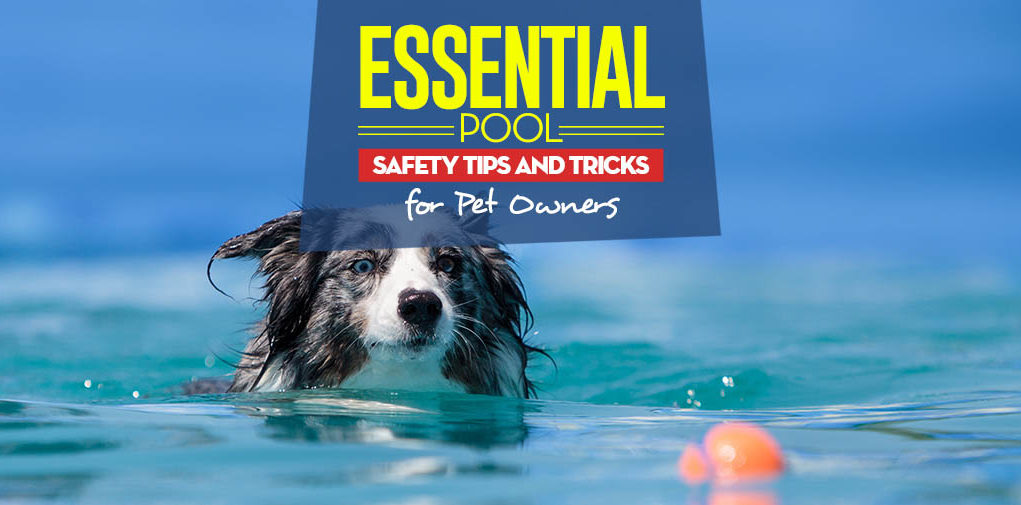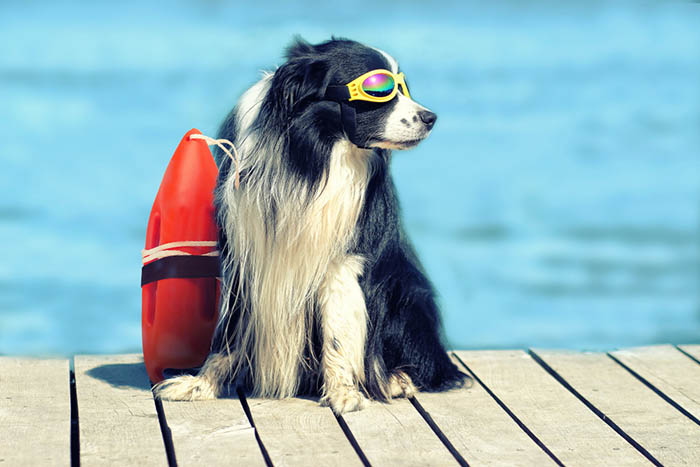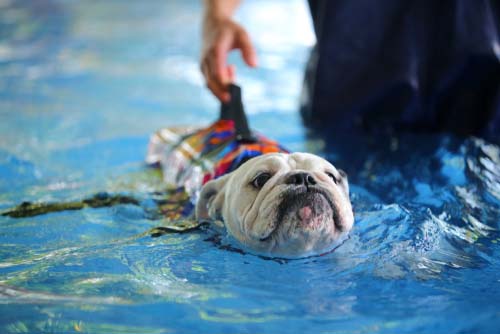Summer allows for many adventures you can have with your dog. But it also means high temperatures, which can be dangerous to dogs and cats. The most common things to watch out for are hot asphalt, dehydration and heatstroke.
Table of Contents
The best way to avoid heatstroke in dogs is to provide them with a way to cool down, and there's nothing better than a dog pool placed in a shadow for your pooch to relax in. Dogs and their owners who have a large pool in the backyard are even luckier. Swimming in the pool does not only provide relief from heat for the dog, but it's good for their health, too.
You probably already have pool safety taken care of for your whole human family, but what about your pets? That fence which keeps out children may not keep out dogs and cats, and there are certain pool dangers that you may not have considered.
7 Pool Safety Tips for Dogs and Cats
1. Learn Animal CPR
CPR (Cardiopulmonary Resuscitation) is not just for people. It can be successfully performed on any mammal including dogs and cats. Should the unimaginable happen, you need to be prepared to provide aid in the event of an emergency. Mammal CPR is basically the same for any species. Here's a dog CPR guide you can investigate for more details, but the basics are like so:
- Lay pet down on their right side.
- Straighten head and neck as much as possible to avoid blocking the airway.
- Use your fingers to feel in the throat and clear it of any blockages.
- Pull the tongue between the teeth so that it cannot block the airway.
- Put your hand around the muzzle making sure the mouth stays closed.
- At the point where elbows touch the chest (in middle of the chest) begin quick compressions.
- Put your mouth over the pet's muzzle and breathe in after every 15 compressions.
To make sure you have it down pat, it may be best to watch some videos on YouTube before an accident happens. This First Aid Guide has some more helpful advice for dog owners, and the below videos explain well how to perform CPR for pets.
Dogs – This video is very informative and uses a dog mannequin explaining how to perform CPR for dogs.
Cats – In this video, a cat mannequin is used to demonstrate the technique of doing CPR for unconscious cat.
2. Have an Exit
Most dogs and cats can swim. The problem with them being in a pool is that they cannot find a way out. Eventually, they will tire and may drown. Luckily, there are devices that you can easily install in your pool area that will prevent this.
Dogs – There are special doggy steps or water ramps that provide an easy exit should your canine fall or jump into the pool.
Cats – Being more creative, felines may find it easier to walk out on a ramp. For these pets, there are cheap ramps like this one to help your cat move to safety.
3. Fences
Whether you already have an invisible fence around the pool, or you still need to put one up, there is special fencing that helps to prevent cats or dogs from crossing into the pool area. While people usually think about having a fence for the neighborhood kids, for the safety of furry friends, consider putting up a proper pool fence that works for pets, too.
Dogs – While the fence described below could also work for dogs, if you don’t have cats, another way exists. It's called Coyote Rollers. This is a very easy and no pain alternative to electric fencing.
Cats – Fences for cats have a top that curves in towards the area were the cats would be jumping from. They have several companies that offer it. Some of them, like this one, are very expensive. For alternatives, this company sells original fencing as well as parts to adapt your current fence to a cat-proof fence.
4. Swimming Lessons
While it is assumed that most animals already know how to swim, and canines are naturally good at doggy paddling, it isn’t true for every single dog or cat. Some breeds should never go in the water, like Basset Hounds, but if you have a cat or dog that should be able to swim, make sure they definitely can.
Dogs – If you are unable to find an organization near you that gives swimming lesson for dogs, you can do it yourself. There are some free resources online, like this article, that give step by step instructions to teach your dogs swimming and get them ready for the water.
Cats – While cats generally don't come close to water, most already know instinctively how to swim. If you have a pool and want to make sure your cat is safe in the water, this post explains how one family trained their cat to swim.
5. Use a Life-jacket
People seem to have an aversion to life-jackets. Every year, there are human deaths that could have been prevented simply by wearing a life-jacket. The same holds true for pets. They may be bulky, but it can be the thing that eventually saves a life.
Dogs – Dogs rarely fall into the water on accident. They usually go in because they like it. You may even encourage your canine to come in and enjoy the summer fun in the pool. If your pooch is small and possibly a bad swimmer, make sure they always wear a doggy life-jacket.
Cats – Many cats hate the water, but a few do love to swim. They may even enjoy taking baths, frolicking in the pool, and going for boat rides with their people. If that is your (rare) feline, make sure they wear a life-jacket that is specially designed for cats, like this one, anytime you plan to have watery fun.
6. Signs of Heatstroke
People don’t usually think of heatstroke or heat exhaustion when the dog or cat is in the water, but it is still a risk both to people and animals. When the temperatures are high, always make sure there's plenty of fresh, cool water is available for your pets, as well as shaded areas for them to rest. Stay alert for the below signs of heat stroke in pets:
- Panting with tongue out.
- Excessive thirst.
- Glazed eyes.
- Vomiting and diarrhea.
- Bright or dark red tongue and gums.
- Elevated heartbeat.
Once heatstroke occurs, there is often little that can be done and it can be fatal.
Dogs – Heatstroke in dogs sets in at around 109° degrees, so pet owners need to learn the signs of overheating in dogs, and how to counteract them.
Cats – Once the temperature reaches 105° degrees in cats, heatstroke is imminent. Because of their small bodies, there's barely any time to do anything after that.
7. Have a Plan
You may know everything you need to do in the event of an emergency, but because many people “freeze”, you need a step-by-step plan that you have reviewed and memorized so you can react quickly. Make sure you are prepared for anything. Here are some things to consider:
- Have a pet first aid kit for cuts and sores on paws or elsewhere.
- Always have the number and address to the nearest emergency vet.
- Have a thermal blanket in case your pet goes into shock, like this one.
- Get certified in both animal and human CPR.
- Make sure to occasionally practice CPR for cats and dogs to remember it.
- When going into open waters for swimming or boating, have extra flotation devices close at hand so you and your pet can leave the water safely.
Because it is rare, some owners simply don’t think about the emergencies that can happen while their pets are around water, whether in the pool area or near lake, ocean. But accidents happen all the time, as this article reported, and by planning for it before the accident occurs you can avoid a tragic loss of life.
READ NEXT: 8 Steps to Preventing and Treating Heat Stroke in Dogs
Disclosure: We may earn affiliate commissions at no cost to you from the links on this page. This did not affect our assessment of products. Read more here and find full disclosure here.


















